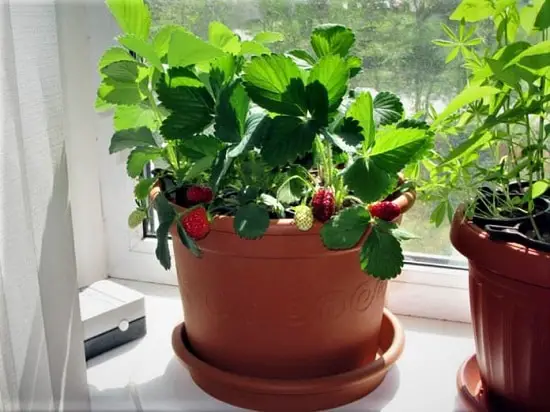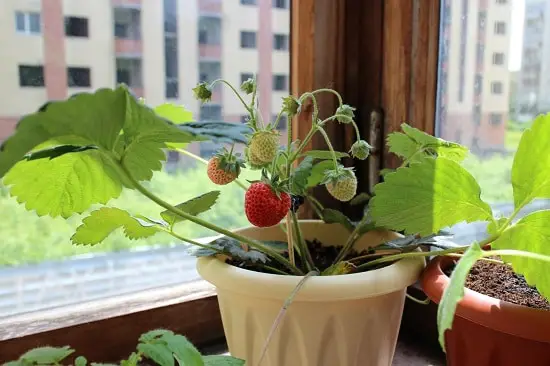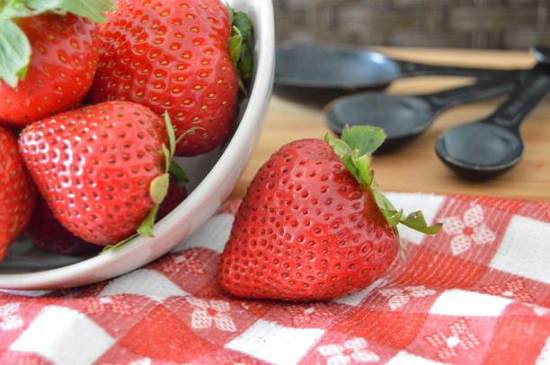Learn everything about Growing Strawberries Indoors in a limited space year-round productively in this informative post!
Growing Strawberries Indoors
Propagation
You can grow strawberry from seeds:
- Fill the seed starting tray with half-inch of soil, one-fourth of potting mix, and three-fourth of peat moss.
- Sprinkle seeds on the top of this growing medium after moistening it with water.
- Add a very thin layer of peat moss over it by lightly sprinkling it over the seeds.
- The seeds will germinate soon and will be ready for transplanting when they have grown 3-4 sets of true leaves.
However, since you’re growing strawberries indoors, you can skip this method. Assuming you may plant just a few plants and strawberries grown from seeds take time to bear fruits, it’s better to avoid that.
The better option is to get healthy and disease-free strawberry transplants from any local nursery nearby or online store. If you have existing berry plants, you can quickly multiply them from their runners. Majority of strawberry varieties produces runners, except a few.
You can grow strawberry from runners:
- Plant the tip of the runner in a separate pot close to the mother plant.
- Cut it once you see some growth in the new clone plant.
Strawberry plants exhaust a lot of energy in producing runners, and our advice for the indoor plant growers is to prune them off so that they can concentrate their energy on fruits and flowers.
Planting
Select the healthy transplants and gently remove them from their mini pots without disturbing the roots and plant them in desired planters, without burying the crowns in fresh potting soil. Don’t forget to trim the discolored and diseased leaves if any before planting.
Also Read: Everything About Growing Strawberries
Choosing the Variety
For indoor growing, look out for compact varieties that remain short and neat during their growth. Strawberry cultivars that produce less or no runners are most suitable for this purpose.
There are various factors to consider when it comes to selecting the right strawberry cultivar. These include taste, size, freezing, canning and jams, and container growing. For instance, sparkle variety has an intense flavor, but fruits are medium-sized, whereas June-bearing Honeoye is resistant to soil-borne diseases and produces large-sized berries. For container growing, one the best cultivar is day-neutral Seascape–It’s smaller in size, flavorful and produces large fruits.
If you want the longest fruit-bearing season strawberries, day-neutral varieties are best:
- They even fruit year-round in certain climates. Also, they’re very productive.
- One more advantage of these types of strawberries is their fruiting doesn’t depend on the length of the days, which is good if you’re using grow-lights. which are also known as
You should also look for Alpine strawberries, which are also known as Wild strawberries as they have all the qualities mentioned above:
- They grow in the wild in lack of sunlight, in harsh weather conditions, they can produce well in part sun.
- They don’t produce runners and remain compact, suitable for limited space.
- They produce small but very flavorful, sweet and fragrant strawberries.
Pot Size for Strawberries
Strawberries have a shallow root system. You can grow multiple plants in a single pot, in a cramped space. A 6 to 8 inches deep flowerpot that is wide similarly or more, preferably a window box would be fine. Maintain 3-4 inches of spacing between each plant, you can grow them this closely, but you’ll need to water more often.
You can also grow strawberries vertically in hanging baskets, PVC pipes as well as in grow towers, here’re a few ideas!
Requirements for Growing Strawberries Indoors
Location
Any fruit or vegetable plant grows best in full sun. When growing strawberries indoors, place them on a sunny windowsill or close to the glass door, much better if you have a small balcony. Any part in your home that receives minimum 5-6 hours of sunlight would suffice. Also, make sure you don’t keep your strawberry plants close to hot and cool air vents of air conditioner and heaters.
In case of low light, place the plants under artificial light, no more than 16 hours per day. Ideally, 12-14 hours! Put the full spectrum LED grow lights above the pots following the manufacturer’s instruction. You can use the timer so that your grow lights turn off automatically after the sunset or do it manually to give rest to your strawberry plants in the night.
Soil
Slightly acidic soil with pH in the range of 5.3 to 6.5 is most suitable, but neutral soil is also acceptable for planting strawberries. Light and well-draining soil that is rich in organic matter such as humus, compost, or well-rotted manure can do wonders. Make sure the soil is free from any contamination.
Watering
Generally, keep the soil slightly moist all the time but not overly drenched. If there is not much sunlight and the air around the plants is cold and damp, water only when 1 inch of topsoil is dry. Morning is the best time for watering!
Strawberry Plant Care Indoors
Fertilizer
Provide a well-balanced liquid fertilizer diet such as 20-20-20 or Dyna Grow Foliage Pro 9-3-6 fertilizer as it has all the micronutrients required, once in every 2-3 weeks.
Whichever fertilizer brand you choose, make sure it has Calcium and Magnesium in it, especially if your soil is acidic. You can also feed the strawberries with tomato or rose fertilizer, once the flowering starts.
Reduce fertilizer dose or increase the duration before feeding again if your strawberry plants show the symptoms of overfertilization such as yellowing or wilting of lower leaves, brown leaf tips, and margins. For more details, check out this informative article on Pennsylvania State University extension.
Pruning
Prune the runners to direct the plant’s energy on growth and production of more fruits. Also, remove the unwanted flowers.
Prune back the plant after the fruiting season is over. The best way to do is by removing all the foliage except the central young leaves. Don’t wait too long as the plant will heal itself if the weather is still warm.
Pollination
You’ll need to hand pollinate the strawberry flowers, doing this using any soft brush–paint or makeup brush would be fine.
Harvesting
Strawberries that are soft, aromatic, and red are ripe and ready to be picked. Generally, the berries are available for harvest in around 4-6 weeks after the blossoms. You can pluck them as you see them to consume fresh and juicy strawberries.
Pests and Diseases
One of the main advantages of growing strawberries indoors is you don’t have to worry about the pest problems. Still, you’ll need to keep an eye on common garden pests such as mites and aphids.








Katia gives a brief overview of the strawberry market in the UK, a market where strawberries are an incredibly popular berry and yet are for the most part only grown outside or inside a poly-tunnel environment. This means that they are imported from afar out of season, an ideal scenario would be to grow them locally all-year-round indoors as a more sustainable solution.